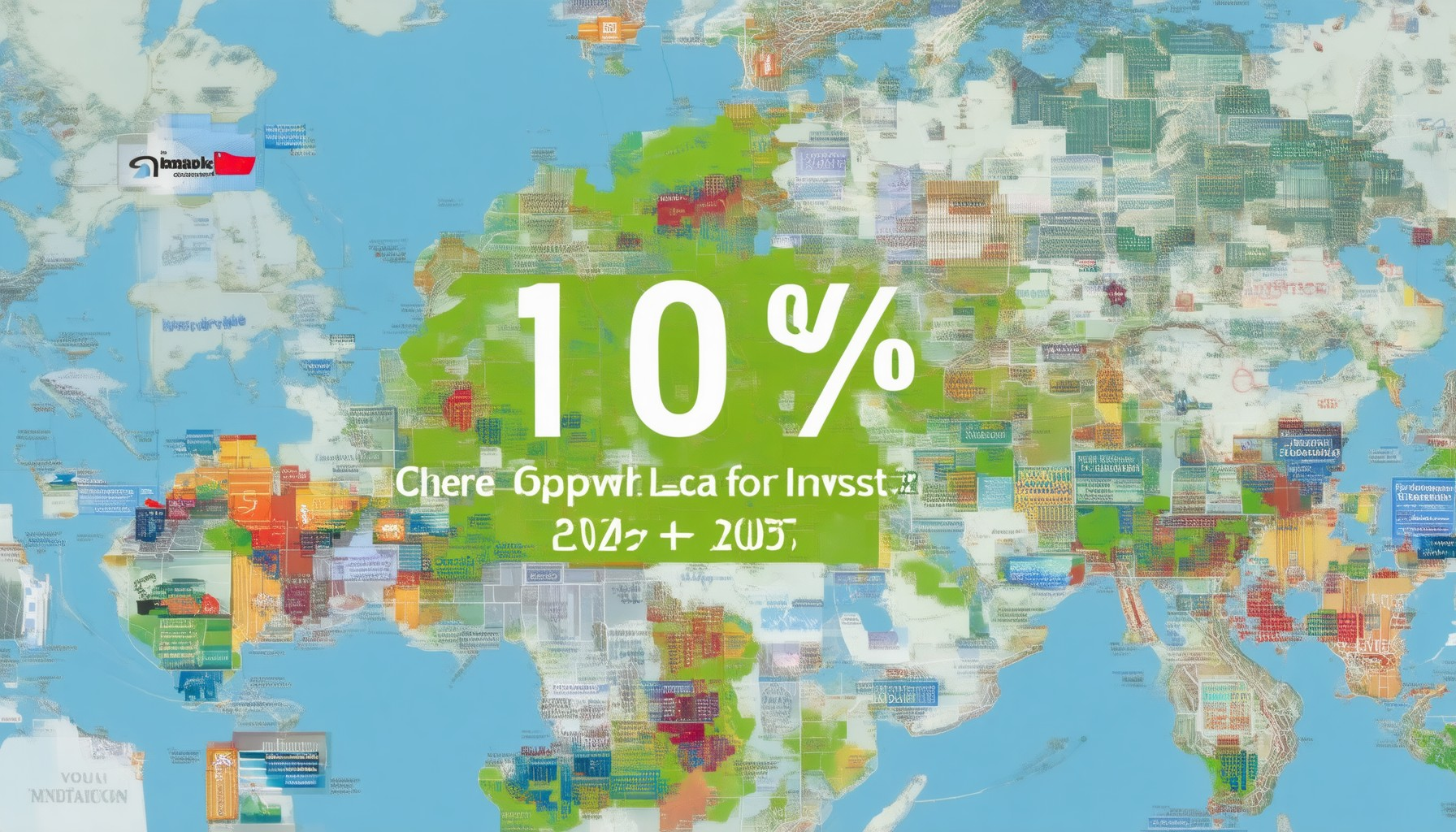Investing wisely requires a deep understanding of how location can significantly impact your returns. Whether you’re aiming for a modest 10% return or ambitious 15%, identifying the right growth locations is crucial for maximizing your investment potential. From bustling urban centers to emerging market hotspots, the choice of where to invest can mean the difference between steady growth and stalled progress. This article delves into the top growth locations in 2025, offering insights into how strategic placement can drive success. Explore the best investment growth locations, including key cities in the USA and beyond, to discover where your money can thrive. By aligning your investment strategies with these prime spots, you can unlock long-term gains and secure your financial future.

Where Can I Get a 10% Return on My Money?
To achieve a 10% return on your investment, consider exploring the following options:
- Stock Market Investments: Invest in ETFs or index funds that track major indices like the S&P 500, offering diversified exposure to top-performing companies with relatively lower risk compared to individual stocks.
- Real Estate Investment Trusts (REITs): These allow indirect investment in real estate through managed funds, providing potential for rental income and property appreciation without the need for direct ownership.
- Bond Investments: Consider government or high-yield bonds for steady returns, though returns may be modest compared to riskier investments.
- Cryptocurrency: While volatile, investments in Bitcoin or Ethereum have shown significant growth potential, though this is considered a higher-risk option.
- Peer-to-Peer Lending: Platforms like LendingClub enable lending to others for potential interest income, though this carries risks associated with borrower defaults.
- Dividend-Paying Stocks: Invest in companies with strong dividend histories for consistent income generation and potential capital appreciation.
- Alternative Investments: Explore options like art or collectibles for potential appreciation, though these are highly speculative and illiquid.
Consider your risk tolerance and investment goals. A diversified portfolio across asset classes can mitigate risk while seeking higher returns. Evaluate fee structures and consult a tax advisor to optimize your financial strategy. Educate yourself through research and educational resources to make informed decisions tailored to your financial situation.
Where Can I Get a 15% Return on Investment?
To achieve a 15% return on investment, consider exploring various avenues that align with your risk tolerance and financial goals:
- Equity Mutual Funds: Invest in equity mutual funds, particularly those focusing on large-cap and mid-cap stocks, which historically have delivered strong returns. Look for funds with a proven track record, such as those mentioned in recent market analyses.
- Real Estate Investment Trusts (REITs): Consider REITs for steady returns through dividends. These are ideal for those seeking passive income and are known for their consistent dividend payouts.
- Peer-to-Peer Lending: Explore platforms like LendingClub or Prosper for earning interest on loans. This option offers relatively low risk and the potential for steady returns, depending on regulatory conditions in your region.
- Dividend-Paying Stocks: Invest in stocks that regularly distribute dividends. A diversified portfolio of these can contribute to cumulative returns over time.
- Diversification Strategy: Spread investments across different asset classes, including mutual funds, stocks, and bonds, to mitigate risk and optimize growth potential.
- Index Funds: For a balanced approach, consider index funds that track major market indices, offering stability and growth without excessive volatility.
- High-Yield Bonds: As a more conservative option, high-yield bonds may provide decent returns, though they typically yield less than equities.
For tailored advice, consult a financial advisor to align your investment strategy with personal financial objectives and risk preferences. Stay informed about market trends to capitalize on emerging opportunities.

Best Investment Opportunities in 2025
Investing wisely requires careful consideration of various factors such as risk tolerance, market trends, and economic conditions. Here are some of the most promising investment avenues for 2025:
- Real Estate: Investors should look into growing cities with strong job markets and infrastructure development. Cities like Austin, Dallas, and Berlin are currently experiencing significant growth, making them attractive options for real estate investments.
- Emerging Markets: Countries with rising economies, such as Indonesia and Brazil, offer potential for higher returns. These markets are often undervalued and have the capacity for substantial growth.
- Dividend Stocks: For those seeking stability, dividend-paying stocks can provide a reliable income stream. Platforms like Finviz and Dividend.com can help identify high-quality dividend stocks.
- Index Funds: To mitigate risk, consider investing in low-cost index funds that track major stock exchanges. Vanguard’s S&P 500 ETF is a popular choice due to its diversification and lower volatility.
- REITs: Real Estate Investment Trusts (REITs) allow investors to participate in real estate without the hassle of direct ownership. Sector-specific REITs, particularly those focused on technology and healthcare, are currently performing well.
- Cryptocurrency: While risky, cryptocurrencies like Bitcoin and Ethereum continue to attract investors. However, this is best suited for high-risk-tolerant investors seeking short-term gains.
- Gold: As a hedge against inflation, gold remains a traditional safe asset. Consider purchasing physical gold or ETFs like SPDR Gold Shares (GLD) for exposure to this market.
It’s crucial to align your investment choices with your risk tolerance and long-term financial goals. Consulting with a financial advisor can provide personalized strategies tailored to your circumstances.

The 2% Rule in Real Estate
The 2% rule is a popular guideline used by real estate investors to determine the minimum rent they should charge for a rental property. The rule suggests that rent should be set at 2% of the property’s purchase price to cover the mortgage payment. Here’s a breakdown:
- Calculation Method: Multiply 2% of the property’s purchase price by 12 to get the monthly rent amount.
- Example: If a property costs $200,000, 2% is $4,000 annually, leading to a monthly rent of approximately $1,333.
This rule aims to help investors achieve positive cash flow by ensuring rent covers the principal portion of the mortgage. However, it’s crucial to consider additional expenses such as utilities, taxes, and maintenance when determining the final rent amount. The 2% rule is typically used for properties expected to generate steady rental income and is often adjusted based on local market conditions and property type.
The 50% Rule in Real Estate
The 50% rule in real estate is a commonly referenced guideline used by investors to evaluate potential profitability and manage expenses. Here’s a breakdown of its application:
- Profit Margin Estimation: When flipping a property, the 50% rule calculates the expected profit as a percentage of the purchase price. For example, buying a property for $100,000 with $20,000 in renovations and selling it for $150,000 yields a $50,000 profit, representing a 50% return on the original price.
- Rental Property Management: In rental property management, the rule suggests that repair and maintenance expenses should not exceed 50% of the monthly rent. If the rent is $1,000 per month, annual allowable expenses are up to $500.
This rule helps investors set realistic expectations for profits and maintain financial health by avoiding excessive spending on repairs or maintenance.

What is the 80% Rule in Real Estate?
The 80% rule in real estate is often referenced in various contexts, but it primarily relates to home insurance and property valuation. Here’s a breakdown of its significance:
Understanding the 80% Rule
The 80% rule typically refers to the practice where home insurance policies cover 80% of the home’s replacement cost. This means that the policyholder is responsible for covering the remaining 20%. Replacement cost is generally calculated based on the home’s current value, not the purchase price.
Application in Property Valuation
In property valuation, the 80% rule is sometimes used to estimate the potential sale price of a property. By determining 80% of the property’s appraised value, agents can set a competitive listing price that aligns with market conditions and buyer expectations.
Impact on Property Taxes and Maintenance
For property taxes, the 80% rule may influence tax assessments. If a property’s assessed value is determined to be 80% of its market value, the owner may pay taxes based on this lower amount. This can affect maintenance priorities, as owners may opt to invest in upgrades to increase property value toward the 100% mark.
Strategic Considerations for Investors
Real estate investors often use the 80% rule to evaluate potential properties. By calculating 80% of the property’s rental income or profit potential, investors can assess whether the property meets financial criteria for profitability and sustainability.
Competitor Insights
When evaluating real estate opportunities, consider visiting platforms like Zillow or Realtor.com for comparative market analyses and local market trends. These tools can provide deeper insights into pricing and valuation strategies aligned with the 80% rule.
Conclusion
The 80% rule serves as a valuable guideline across various aspects of real estate, from insurance and valuation to investment and taxation. Understanding its applications can empower buyers, sellers, and investors to make informed decisions tailored to their goals and market conditions.




0 Comments